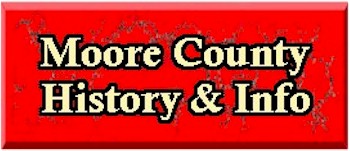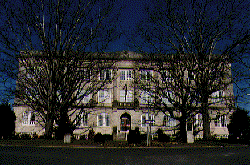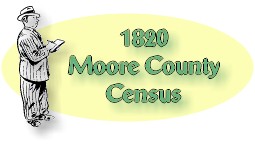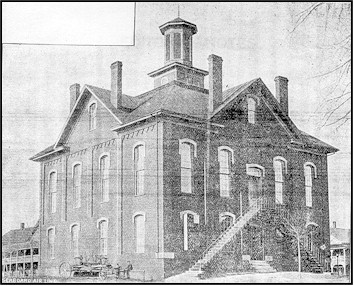@2009 - Sue Ashby


Moore Co. Courthouse as it appears today
A BIT OF MOORE COUNTY HISTORY
Moore County was formed in 1784 from
Cumberland
County. It was named in the honor
of Captain Alfred Moore of
Brunswick, a soldier of the Revolution and
afterwards a judge of the Supreme Court of
the United States. Moore County
is in the south central section of the State
and bounded by Harnett, Hoke, Scotland,
Richmond,
Montgomery, Randolph, Chatham, and Lee
counties.
The act establishing the county provided for
the erection of the public buildings. In 1795 an act was passed which
stated
that the location of the courthouse was inconvenient; it named
commissioners
to purchase land near the center of the county and erect a new
courthouse.
In 1796 an act was passed establishing Carthage on land where the
courthouse
was to stand. In 1803 an act was passed naming commissioners to lay out
a town and build a courthouse as directed in the act of 1796. In 1806,
Carthage was changed to Feaginsville. In 1818, "Feaginsville" was
changed
back to Carthage, and is now the county seat.
*
The surface of the county is moderately
uneven;
in the northern part there is clay foundation
and much good land; the southern part has
sandy land with heavy pine forests;
western is hilly and abounds with minerals,
gold mines, millstones & c.(?)
The water power is very good, there being
many never-failing streams. Good timber is abundant.
The county is now well supplied with
railroads;
in fact it claims to have the
largest mileage of any county of this State.
Almost every product raised in the State
can be raised in Moore County. There is no
good reason whay this may not be,
in a very few years, one of the very richest
sections of North Carolina.*
* Levi Branson, 1898
![]()
|
From _Moore County North Carolina 1747-1847_ by Blackwell P.
Robinson:
p.154 - "Before the American Revolution there are few records
pertaining
to schools or education in Cumberland-Moore. The schools that did exist
were those conducted in the home as a private undertaking or those of
he
"old field" or neighborhood type. In addition, there was the
apprenticeship
system, . . . .In general, the "old field" school was conducted at the
residence of the teacher. . . . |
| Year of Census | Population |
| 1790 | 3,770 |
| 1800 | 4,767 |
| 1810 | 6,367 |
| 1820 | 7,128 |
| 1830 | 7,745 |
| 1840 | 7,988 |
| 1850 | 9,342 |
| 1860 | 11,427 |
| 1870 | 12,040 |
| 1880 | 16,821 |
| 1900 | 20,479 |
| 1910 | 17,010 |
| 1920 | 21,388 |
| 1930 | 28,215 |
| 1940 | 30,969 |
| 1950 | 33,129 |
| 1960 | 36,733 |
Moore County history is hard to find. If any one would like to add
some here, you are most welcome to.

Moore County Genealogical Society, Inc.
Post Office Box 1183
Pinehurst, North Carolina 28374-1183
Moore County Historical Association
Post Office Box 324
Southern Pines, North Carolina 28388

![]()
Excerpts from
Branson's 1898 Moore County,
NC
Business Directory
| Lands for sale listed with
D, A, McDonald
of Carthage:
No. 1 52 acres, Ritter Gold Mine, 10 miles from Carthage (County seat), Price $10,000. No. 2 15 acres, 1 1/2 miles from Carthage, berry and grape land, uncleared, $100.00 No. 3 Five 10 acre tracts near Railroad, 1 1/2 miles from Carthage, suitable for vineyards, berries and fruit trees, price per tract, $100.00 No. 4 1,000 acres on A. & W. E. R. R. Grape and
fruit lands, No. 5 183 acres, 1/2 mile from Curriesville, on
Carthage and
Western Railroad. |
1800 Moore Census is online at the Moore Archives.
Moore Co. Archives the Bethlehem Baptist Church Cemetery.
![]()
Moore County Railroads 1898
| Carthage Railroad | 21.60 miles |
| Hallison Branch | 9.00 " |
| Moore County Railroad | 12.50 " |
| Raleigh & Augusta Air-Line | 43.86 " |
| Aberdeen & Ashboro | 23.35 " |
| Cape Fear & Yadkin Valley | 14.68 " |
| Aberdeen & Rockfish | 3.25 " |
| Durham & Charlotte | 20.00 " |
| Southern Pines & Pinehurst | 7.00 " |
| Having altogether | 155.24 miles |
HISTORIC NOTES
Residence of Anderson Jones
- In the Horseshoe on Deep River is the house that
was once owned by Co. Phil. Alston, in
Revolutionary
times. A battle fought on one
Sunday mornig there between Alston and David
Fanning, the Tory;
some eight men were killed, among whom was
one English officeer.
Bullet holes are still to be seen in the walls
of the house. The house stands
on the north side of Deep River, in the
Horseshoe,
and about three hundred
yards from the river bank. It was afterwards
the residence of Benjamin W. Williams
while he was Governor. The house is still
in good repair and is supposed to be about 150 years old.
(It is now known as the House
in the Horseshoe. Every August they hold a reenactment
and is open to the
public.
FYI 910/947-2051)
W. D. Harrington's Residence
- Is situated on the south bank of Deep River
and Governor Creek, about thre hundred yards
from the bank of Deep Rivers
and the same distance from the creek. It was
the last residence of
Governor Benjamin W. Williams, and his remains
lie buried near the residence.
A Confederate soldier by the name of Holleman
was drowned at Glenn's Mill on his way home from
Lee's surrender, and was buried at Tyson
Graveyard,
near to Glenn's Mill, in sight of Glendon.
Cross Hill, of
Revolutionary
fame - Lord Cornwallis camped at Cross Hill,
one mile west of Carthage. His horse bit off
the top of a young mulberry tree,
which tree is yet still standing. (as of 1898)
His horse-comb was found under the tree
many years after the war. Dr. George Glasscock
resided at Cross Hill; he was a surgeon
in our army at Guilford Courthouse. He was
first cousin of George Washington - sister's children
Mary Ball and Esther Ball. He was killed about
1790 by a negro and was buried at the place.
Burkett's Church, M. E.,
South
- (First text: "Lord, who hath believed our report") -
was one and a half miles northwest of
Carthage,
and was the place of the first
Methodist preaching in this county, by a
preacher
- a Mr. McDonald - a Scotchman.
This church is not now standing, the members
having built a new church in Carthage.
Mrs. Fannie McNeill,
widow
of John McNeill, who was a hatter and died in 1840.
Mrs. McNeill is approaching her 84th year
- will be October 17th - born in 1814.
Maiden name was Muse, resided at Muse's
Station,
on the old Fayetteville stage road.
![]()
Moore County Courthouse - 1898

The Court-house intersects the main avenue
on the highest ground. It is a substantial
and imposing building. Here you find the
offices
of D. A. McDonald,
Clerk of the Superior Court (successor to
Col. A. H. McNeill,
who held the office for thirty-two years),
Samuel M. Jones, Sheriff,
W. H. Battley, Register of Deeds, the County
Commissioners, the
Superintendent of County Schools, and
W. H. McNeill, Esq., Mayor of Carthage.
The Court house is a great center for the
gathering of the hoi polloi.
Here they meet, especially on court weeks,
to exchange courtesies and gather county news.
![]()
Post-Offices of Moore County in 1898
(Names, Locations, Postmasters, Estimated Population)
| Aberdeen,
75 ms s w Raleigh, H H Powell, pop 1,000 Antler, 8 ms s Carthage, J W McCaskill, pop 25 |
| Bensalem,
SP Seawell, pop 40 Big Oak, 15 ms s w Carthage, pop 50 Blink, 12 ms s w Carthage,J S Sheffield, pop 60 Broadway, 24 ms e Carthage, M M Watson |
| Caledonia,
15 ms w Carthage, D M Cannady, pop 50 Cameron, 10 ms s Carthage, Mrs. Flora McFayden, pop 350 Carbonton, 5 ms n Gulf, J A Jones, pop. 150 Carter's Mill, 14 w Carthage, W G Carter, pop 50 Carthage (C H), Mrs. Julia A Ritter, pop 1,500 Chiloe, 7 ms s Carthage, Thad McLean, pop 20 Clarks Mills, 20 ms s e Carthage, pop 50 Coffer, 8 ms e Carthage, John Coffer, pop 30 Curriesville, 10 ms w Carthage, D A B Currie, pop 100 Craigrownie, 13 ms w Aberdeen, pop 100 |
| Eagle
Springs, 14 ms w Carthage, John F Reynolds, pop 250 Endon (Cumberland Co.), 16 ms s Carthage, W D Cameron Euphronia, 12 ms n e Carthage, pop 50 |
| Fair
Haven, 12 ms n Carthage, Dabney Phillips, pop 75 Flynn, 12 ms w Carthage, H H Martin, pop 40 Forkade, 25 ms e Carthage, pop 25 Fall Creek (Chatham Co) |
| Gilbert, 12 ms ne Carthage, Jesse D
Spivey, pop
40 Glendon, 12 n e Carthage, A J Jones, pop 150 Greenwood, 9 ms e Carthage, J M Cole pop 50 Grotto, 7 ms e Carthage, J C Thomas, pop 50 Gulf (Chatham Co) |
| Horners, 8 ms n w Carthage, W Y Horners,
pop 50 Hallison, 9 ms n w Carthage,pop 25 High Falls, 19 ms nw Carthage, Thos N Woody, pop 250 |
| Jackson Springs, 4 ms s Westebd
Depot A
& A R R , pop 50 Jessup, 12 ms n e Carthage, pop 25 Johnson, 9 ms ne Carthage, pop 50 Jonesboro, 18 ms s e Carthage, S H Buchanan, pop 1,500 |
| Kyser, 22 ms s Carthage, Miss Mattie Register, pop 250 |
| Lawhon, 7 ms w Carthage, Mrs. Nora
Lawhon, pop
150 Lemon Springs, 7 ms s Sanford, G W Smith, pop 100 Lonely, pop 25 Longleaf, 20 ms s Carthage, T H Davis, pop 60 |
| Manly, 12 ms s Carthage, W H Allen, pop
100 Mooshaunee, 7 ms n Carthage, J T Seawell, pop 100 Mount Carmel, 8 ms n w Carthage, L R McIntosh, pop 125 Montrose (Cumberland Co), 15 ms s Carthage, D P Campbell |
| Noise, 19 ms w Carthage, Mr Maness, pop 150 |
| Old Stores, 18 ms w Carthage,
John C Currie,
pop 25 Ollie, pop10 |
| Parkwood, 7 ms n Carthage, J E Taylor,
pop 25 Pattersons Bridge, 20 ms s w Carthage, J E Patterson, pop 75 Pine Bluff, 18 ms s w Carthage, Levi Pockard, pop 150 Pinehurst, 6 ms w Southern Pines, C D Benbow, pop 300 Pocket, 12 ms n Carthage, Newton Poe, pop 25 Prosperity, 12 ms n Carthage(N bank of Deep River),L Fineson, pop 200 |
| Quiet, 8 ms e Carthage, E T Edwards, pop 25 |
| Roseland, 5 ms s w Aberdeen, C J Brown,
pop 75 Rubican, 6 ms s w Carthage, R A Cole, pop 75 |
| Sanford, 18 ms e Carthage, I H Lutterloh,
pop 1,500 Southern Pines, 14 ms e Carthage, A M Clark, pop 1,000 Spencer, 20 ms n w Carthage, pop 50 Swann Station, 6 ms n w Carthage, pop 50 Swinton, 16 ms n w Carthage, pop 50 Steeds, on A & A R R, pop 100 |
| Tempting, 5 ms w Sanford, C D Gross, pop
30 Thagardville, 7 ms s Carthage, J L Thagard, pop 45 Tyra, 20 ms n w Carthage, pop 50 |
| Vass, 11 ms s Carthage, A Cameron, pop
100 Victor, 5 ms s e Carthage, pop 200 Villanow,9 ms ne Carthage, Dr V N Seawell pop, 50 |
| Westend, 13 ms s w Carthage, pop 200 |
Moore County Schools as of
1898
(Names, Post offices, Principals)
| Aberdeen High School,
Misses Ida and Fannie Carr Carbonton Academy, Frank Edwards Colored Parochial School, Southern Pines, Miss Wheeler Dayton Academy(col), Carthage, Rev H D Wood Hamilton Seminary(col), Carthage, Rev G H Miles James Mark Academy, Lemon Springs, Rev C V Brooks Thompson High School and Business College, Sanford, J A W Thmpson Union Home School, Victor, Prof John E Kelly(w/ 4 assist) Village School, Pinehurst, Miss May Taylor |
Churches in Moore County as
of
1898
(Names, Post-offices, Pastors, Denominations)
| St.Augustine, Carthage, R M Thompson, A M E Z |
| Reive's Chapel, Glendon, G W Gaines, A M E Z |
| Mt. Olive, near Carthage, R M Thmpson, A M E Z |
| Church, Sanford, A M E Z |
| Church, Southern Pines, Mathias Howe, Catholic |
| Turner's Chapel, Jonesboro(5 mi east), A T Barbee, Christian |
| Shallowell, Jonesboro(1 mi east), G R Underwood, Christian |
| Poplar Branch, Jonesboro, (3 mi SW), Christian |
| Moore Union, Lonely, A P Barbee, Chriatian |
| Grace Chapel, Jonesboro(5 mi W), A P Barbee |
| First Church, Southern Pines, G R Ransom, Congregational |
| Friendship, Parkwood, W H H Lawhon, Miss Bap |
| First Baptist, Southern Pines, Rev Cree, Miss Bap |
| Ewing Chapell (col), Carthage, W H Diggs, Miss Bap |
| Church (col), Cameron, W H Diggs, Miss Bap |
| Bethlehem, Carthage (5 mi NW), Rev Cree, Miss Bap |
| Bethlehem, Lawhon, A C Cree, Miss Bap |
| Poplar Springs, Sanford, D L Earnhardt, M E C S |
| Mt Olive, Carthage (3 mi NW), Meth Epis |
| Morris Chapel, Swann Station, D L Earnhardt, M E C S |
| Midway, Lemon Springs, D L Earnhardt. M E C S |
| Church, Jonesboro, D L Earnhardt, M E C S |
| Church, Sanford, D L Earnhardt, M E C S |
| Church, Carbonton, W W Holder, M E C S |
| Bensalem, Caledonia, R M McIntyre, Presb |
| Bethesda, Aberdeen, Charles H Dobbs,Jr, Presb |
| Buffaloe(over 100 years old), Sanford, M D McNeill, Presb |
| Church, Carthage, Charles H Dobbs, Jr, Presb |
| Church, Cameron, McD McNeill, Presb |
| Church, Bensalem, R M McIntyre, Presb |
| Church, Jackson Springs, C W Coppage, Presb |
| Church, Pocket, Presb |
| Church, Sanford, _______ Graves, Presb |
| Church, Sanford, M B McNeill, Presb |
| Church, Sanford, M D McNeill, Pesb |
| Church, Jonesboro, K A McLeod, Presb |
| Culdee Church, Charles H Dobbs, Jr, Presb |
| John's Hall Chapel(col), Carthage, H G Wood Presb |
| Salem, Broadway, R A McLeod, Presb |
| St. Andrews, Lemon Springs, R A McLeod, Presb |
| Union, Victor, M N McIver, stated supply, Presb |
| Union, Victor, M D McIver, Presb |
| White Hill, Villanow, M D McNeill, Presb |
| Emanuel, Southern Pines, Rev Gregory, Prot Epis |
| Church, Sanford, Prot Epis |
North Carolina has had three Constitutions in her history as a
State:
the Constitution of 1776, the Constitution of 1868,
and the Constitution of 1971.
Drafted and promulgated by the Fifth Provincial Congress in
December,
1776, without submission to the people, the
Constitution of 1776 and its separate but accompanying Declaration
of Rights sketched the main outlines of the new
state government and secured the rights of the citizen from
governmental
interference. While the principle of separation
of powers was explicitly affirmed and the familiar three branches of
government were provided for, the true center of
power lay in the General Assembly. That body not only exercised full
legislative power; it also chose all the state
executive and judicial officers, the former for short terms and the
judges for life.
Profound distrust of the executive power is evident throughout the
document.
The Governor was chosen by the
legislature for a one-year term and was eligible for only three terms
in six years. The little power granted him was hedged
about in many instances by requiring for its exercise the concurrence
of a seven-member Council of State chosen by the
legislature. Judicial offices were established, but the court system
itself was left to legislative design. No system of local
government was prescribed by the Constitution, although the offices
of justice of the peace, sheriff, coroner, and
constable were created.
The system of legislative representation was based on units of local
government. The voters of each county elected one
Senator and two members of the House of Commons, while six (later
seven)
towns each elected one member of the
House. It was distinctly a property owner's government, for only
landowners
could vote for Senators until 1857, and
progressive property qualifications were required of members of the
House, Senators, and the Governor until 1868.
Legislators were the only state officers who were elected by the people
until 1836.
![]()